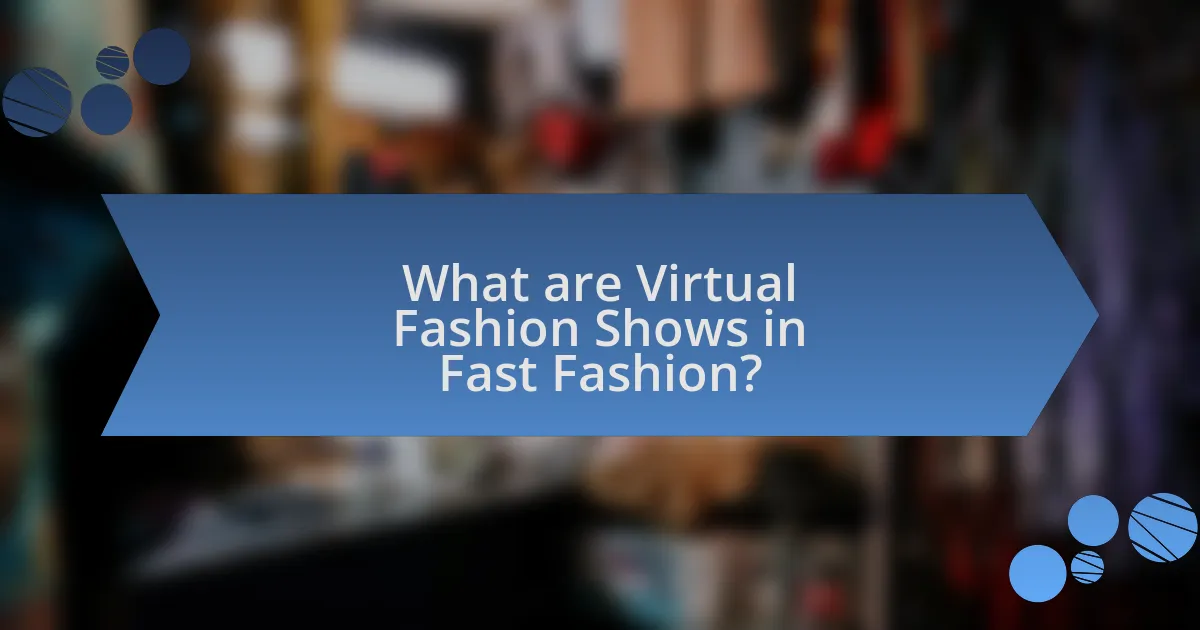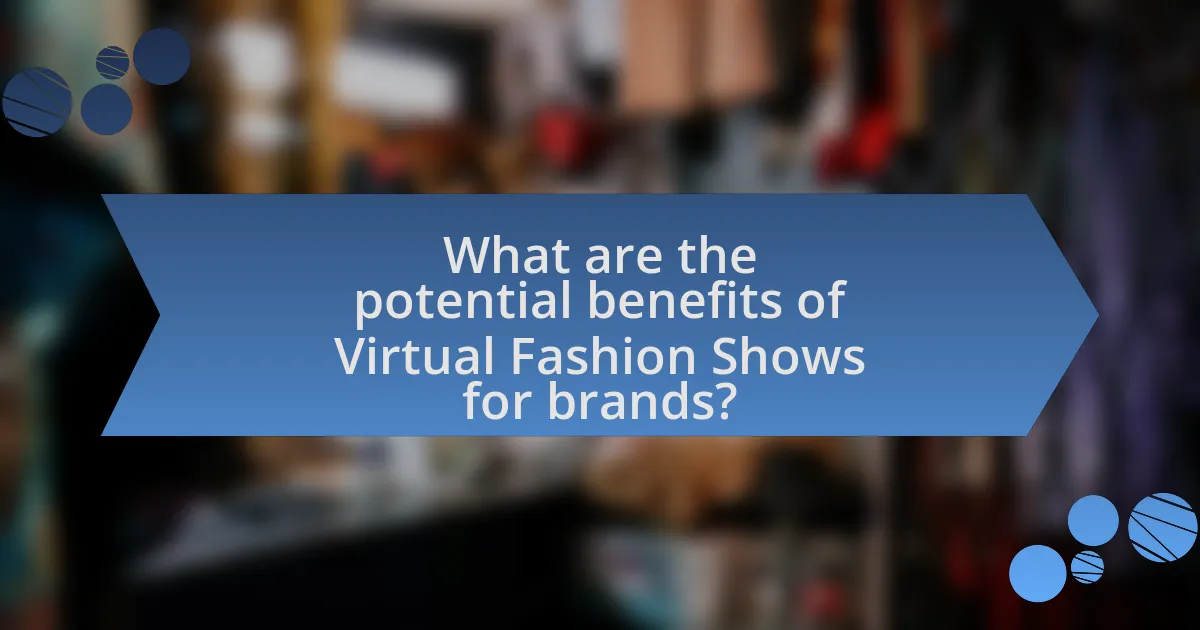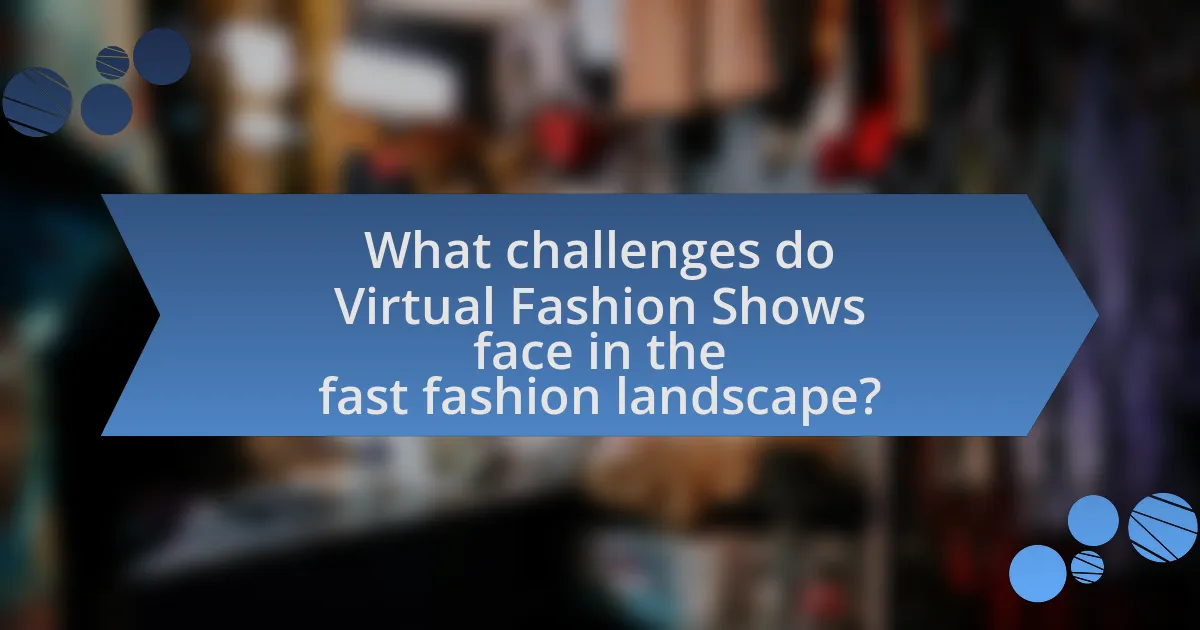Virtual fashion shows represent a transformative shift in the fast fashion industry, utilizing digital platforms to showcase clothing collections through technologies such as 3D modeling, augmented reality, and live streaming. These shows enhance accessibility and engagement, allowing brands to reach global audiences while reducing costs associated with traditional runway events. The article explores the differences between virtual and traditional fashion shows, the technologies involved, audience engagement strategies, and the implications for sustainability and consumer behavior. Additionally, it addresses the challenges faced by virtual formats and outlines best practices for brands to maximize their impact in this evolving landscape.

What are Virtual Fashion Shows in Fast Fashion?
Virtual fashion shows in fast fashion are digital events where brands showcase their clothing collections through online platforms instead of traditional runway presentations. These shows utilize technologies such as 3D modeling, augmented reality, and live streaming to create immersive experiences for viewers. The rise of virtual fashion shows has been accelerated by the COVID-19 pandemic, which limited physical gatherings, leading brands like Balenciaga and Gucci to adopt this format. According to a report by McKinsey & Company, the digital transformation in fashion has increased consumer engagement and accessibility, making virtual shows a viable alternative to in-person events.
How do Virtual Fashion Shows differ from traditional fashion shows?
Virtual fashion shows differ from traditional fashion shows primarily in their format and accessibility. Traditional fashion shows are physical events held in specific locations, often requiring invitations and attendance from industry insiders, while virtual fashion shows are online presentations that can be accessed by a global audience without geographical limitations. This shift to a digital platform allows for innovative presentation styles, such as 3D modeling and augmented reality, which enhance viewer engagement. Additionally, virtual shows can reach a wider audience, as evidenced by the increase in online viewership during events like the 2021 Balenciaga show, which attracted millions of viewers worldwide compared to the limited seating of traditional venues.
What technologies are utilized in Virtual Fashion Shows?
Virtual fashion shows utilize technologies such as augmented reality (AR), virtual reality (VR), 3D modeling, and live streaming. AR enhances the viewer’s experience by overlaying digital elements onto the real world, allowing for interactive presentations. VR creates immersive environments where viewers can experience fashion in a simulated space. 3D modeling enables designers to create detailed digital garments that can be showcased without physical samples. Live streaming technology facilitates real-time broadcasting of these events to a global audience, increasing accessibility and engagement. These technologies collectively transform the traditional fashion show format, making it more dynamic and inclusive.
How do Virtual Fashion Shows enhance audience engagement?
Virtual fashion shows enhance audience engagement by providing interactive experiences that allow viewers to participate in real-time. These shows often incorporate features such as live chats, polls, and augmented reality, enabling audiences to engage directly with the content and designers. For instance, a study by the Fashion Institute of Technology found that 70% of participants felt more connected to brands that utilized interactive elements during virtual presentations. This level of engagement not only increases viewer retention but also fosters a sense of community among fashion enthusiasts, ultimately driving brand loyalty and sales.
Why are Virtual Fashion Shows becoming popular in the fast fashion industry?
Virtual fashion shows are becoming popular in the fast fashion industry due to their ability to reach a global audience and reduce costs associated with traditional runway shows. These digital events allow brands to showcase their collections online, eliminating the need for physical venues and extensive logistics. According to a report by McKinsey & Company, the digital transformation in fashion has accelerated, with 75% of consumers willing to shop online more than before the pandemic. This shift highlights the effectiveness of virtual platforms in engaging consumers and driving sales, making them an attractive option for fast fashion brands looking to innovate and adapt to changing consumer behaviors.
What role does social media play in the rise of Virtual Fashion Shows?
Social media significantly enhances the visibility and accessibility of virtual fashion shows, driving their rise in popularity. Platforms like Instagram, TikTok, and Facebook allow designers and brands to reach global audiences instantly, facilitating real-time engagement and interaction. According to a report by McKinsey & Company, 75% of consumers are influenced by social media when making fashion purchases, highlighting its critical role in shaping consumer behavior and trends. Additionally, the ability to share content virally enables fashion shows to gain traction quickly, attracting attention from influencers and fashion enthusiasts alike, which further amplifies their reach and impact.
How do Virtual Fashion Shows address sustainability concerns?
Virtual fashion shows address sustainability concerns by significantly reducing the environmental impact associated with traditional fashion shows. These digital events eliminate the need for physical travel, which contributes to carbon emissions, and reduce waste generated from materials used in physical displays and garments. For instance, a study by the Global Fashion Agenda indicates that the fashion industry is responsible for 10% of global carbon emissions, and virtual shows can help mitigate this by minimizing the logistical footprint. Additionally, virtual platforms allow for broader accessibility, enabling brands to reach a larger audience without the resource-intensive requirements of in-person events, thereby promoting a more sustainable approach to fashion marketing.

What are the potential benefits of Virtual Fashion Shows for brands?
Virtual Fashion Shows offer brands significant benefits, including increased accessibility and cost efficiency. By utilizing digital platforms, brands can reach a global audience without the limitations of physical venues, allowing for broader engagement and exposure. Additionally, virtual shows reduce costs associated with traditional fashion events, such as venue rental, travel, and logistics, enabling brands to allocate resources more effectively. According to a report by McKinsey & Company, the shift to digital formats can enhance brand visibility and consumer interaction, ultimately driving sales and brand loyalty.
How can Virtual Fashion Shows reduce costs for fashion brands?
Virtual fashion shows can significantly reduce costs for fashion brands by eliminating expenses associated with physical venues, travel, and logistics. Traditional fashion shows often require substantial investments in venue rental, set design, and transportation for models and attendees, which can amount to tens of thousands of dollars. In contrast, virtual fashion shows leverage digital platforms, allowing brands to showcase their collections online without these overhead costs. For instance, a study by McKinsey & Company highlighted that brands can save up to 75% on production costs by opting for virtual formats. Additionally, virtual shows can reach a global audience without the need for physical attendance, further enhancing cost efficiency through increased visibility and engagement without the associated travel expenses.
What are the implications of reduced production costs on pricing strategies?
Reduced production costs lead to more flexible pricing strategies for businesses. When production expenses decrease, companies can either lower their prices to attract more customers or maintain current prices to increase profit margins. For instance, in the fast fashion industry, brands like Zara and H&M often adjust their pricing based on production efficiencies, allowing them to offer competitive prices while maximizing profitability. This strategic flexibility can enhance market share and customer loyalty, as consumers are drawn to lower prices without sacrificing quality.
How do Virtual Fashion Shows expand market reach for brands?
Virtual fashion shows expand market reach for brands by enabling global accessibility and engagement with diverse audiences. These digital platforms allow brands to showcase their collections to a wider audience without geographical limitations, reaching consumers who may not attend traditional runway shows. For instance, during the COVID-19 pandemic, brands like Balenciaga and Gucci successfully utilized virtual shows, attracting millions of viewers online, significantly increasing their visibility and potential customer base. This shift not only enhances brand awareness but also fosters direct interaction with consumers through social media and live streaming, creating a more immersive experience that traditional shows cannot offer.
What impact do Virtual Fashion Shows have on consumer behavior?
Virtual fashion shows significantly influence consumer behavior by enhancing engagement and accessibility. These digital events allow brands to reach a global audience, breaking geographical barriers and increasing visibility. According to a study by McKinsey & Company, 65% of consumers reported a higher likelihood of purchasing items showcased in virtual formats compared to traditional runway shows. This shift is driven by the interactive nature of virtual shows, which often incorporate social media elements, enabling real-time feedback and fostering a sense of community among viewers. Additionally, the immersive experience provided by augmented and virtual reality technologies can lead to increased emotional connection with the brand, further driving purchasing decisions.
How do Virtual Fashion Shows influence purchasing decisions?
Virtual fashion shows significantly influence purchasing decisions by creating immersive experiences that engage consumers and showcase products in innovative ways. These shows leverage technology to present collections in a visually appealing format, often leading to increased brand awareness and consumer interest. Research indicates that 67% of consumers are more likely to purchase a product after viewing it in a virtual format, as it allows them to visualize how items fit into their lifestyle. Additionally, the interactive elements of virtual shows, such as real-time shopping links and social media integration, facilitate immediate purchasing actions, further driving sales.
What demographic trends are emerging from Virtual Fashion Show audiences?
Emerging demographic trends from Virtual Fashion Show audiences indicate a significant increase in participation among younger generations, particularly Gen Z and Millennials. Research shows that these age groups are more inclined to engage with digital platforms, with 62% of Gen Z expressing interest in virtual experiences related to fashion. Additionally, there is a growing diversity in audience demographics, with increased representation of various ethnicities and body types, reflecting a broader societal shift towards inclusivity in fashion. This trend is supported by data from industry reports, which highlight that 45% of virtual attendees identify as non-white, showcasing a departure from traditional fashion show audiences.

What challenges do Virtual Fashion Shows face in the fast fashion landscape?
Virtual Fashion Shows face significant challenges in the fast fashion landscape, primarily due to issues of consumer engagement and technological limitations. The fast-paced nature of fast fashion demands rapid production cycles, which can conflict with the time-intensive processes required for high-quality virtual shows. Additionally, many consumers still prefer the tactile experience of physical fashion shows, leading to lower engagement rates for virtual formats. According to a report by McKinsey & Company, 75% of consumers express a preference for in-person experiences when it comes to fashion, highlighting the difficulty virtual shows face in capturing audience attention. Furthermore, the reliance on technology can lead to accessibility issues, as not all consumers have the necessary devices or internet connectivity to participate fully in virtual events.
How do technical issues affect the success of Virtual Fashion Shows?
Technical issues significantly hinder the success of Virtual Fashion Shows by disrupting the viewing experience and diminishing audience engagement. For instance, problems such as poor internet connectivity, software glitches, and inadequate hardware can lead to lagging visuals or audio, which frustrates viewers and detracts from the overall presentation. A study by McKinsey & Company highlights that 75% of consumers are likely to abandon a digital event if they encounter technical difficulties, underscoring the critical impact of these issues on audience retention and brand perception. Therefore, ensuring robust technical infrastructure is essential for maximizing the effectiveness and reach of Virtual Fashion Shows.
What are common technical challenges faced during Virtual Fashion Shows?
Common technical challenges faced during Virtual Fashion Shows include issues with streaming quality, platform stability, and user engagement. Streaming quality can be affected by bandwidth limitations, leading to lag or pixelation, which detracts from the viewer experience. Platform stability is crucial; technical glitches or crashes can disrupt the show, causing frustration for both designers and audiences. Additionally, engaging viewers in a virtual environment poses challenges, as traditional methods of interaction, such as live audience feedback, are limited. These challenges highlight the need for robust technology and planning to ensure successful virtual events.
How can brands prepare for potential technical difficulties?
Brands can prepare for potential technical difficulties by implementing robust contingency plans and conducting thorough pre-event testing. Establishing a dedicated technical support team ensures immediate troubleshooting during events, while rehearsing the virtual show multiple times can identify and resolve issues beforehand. According to a study by Eventbrite, 70% of event organizers reported that pre-event testing significantly reduced technical problems during live events. This proactive approach minimizes disruptions and enhances the overall experience for participants and viewers.
What are the limitations of Virtual Fashion Shows compared to traditional formats?
Virtual fashion shows have several limitations compared to traditional formats, primarily in audience engagement, sensory experience, and brand impact. Traditional fashion shows allow for direct interaction between models, designers, and attendees, fostering a unique atmosphere that enhances emotional connections. In contrast, virtual shows often lack this personal interaction, which can diminish the overall experience for viewers. Additionally, traditional formats provide a multi-sensory experience, including the ambiance, music, and physical presence of garments, which virtual shows cannot fully replicate. According to a study by the Fashion Institute of Technology, 70% of attendees at traditional shows reported a stronger emotional response compared to virtual formats, highlighting the importance of physical presence in fashion events. Furthermore, the impact of brand storytelling is often less effective in virtual settings, as the immersive environment of a live show contributes significantly to brand perception and memorability.
How does the sensory experience differ between Virtual and traditional fashion shows?
The sensory experience in virtual fashion shows differs significantly from traditional fashion shows primarily in the absence of physical presence and tactile engagement. Traditional fashion shows provide a multi-sensory experience where attendees can see, hear, and feel the atmosphere, including the sounds of live music, the scent of the venue, and the tactile sensation of fabrics. In contrast, virtual fashion shows rely on visual and auditory stimuli delivered through screens, limiting the sensory engagement to sight and sound, which can diminish the overall impact of the fashion being presented. Research indicates that sensory immersion is crucial for emotional engagement, and the lack of physical interaction in virtual formats can lead to a less impactful experience for viewers compared to the rich, immersive environment of traditional shows.
What are the challenges in creating a memorable brand experience online?
Creating a memorable brand experience online faces several challenges, including oversaturation of content, lack of personalization, and maintaining user engagement. The digital landscape is crowded, with numerous brands competing for attention, making it difficult for any single brand to stand out. According to a study by HubSpot, 70% of marketers say that content creation is their top priority, highlighting the challenge of differentiation. Additionally, consumers increasingly expect personalized experiences; a report from Epsilon indicates that 80% of consumers are more likely to make a purchase when brands offer personalized experiences. Finally, sustaining user engagement is critical, as research from the Nielsen Norman Group shows that users typically leave a website within 10-20 seconds if they do not find it engaging. These factors collectively complicate the creation of a memorable online brand experience.

How can brands effectively implement Virtual Fashion Shows?
Brands can effectively implement Virtual Fashion Shows by leveraging advanced technology, engaging storytelling, and strategic marketing. Utilizing platforms like social media and dedicated streaming services allows brands to reach a global audience instantly. For instance, Balenciaga’s 2021 show utilized a video game format, attracting significant online viewership and engagement. Additionally, incorporating interactive elements, such as live chats or polls, enhances viewer participation and connection. According to a report by McKinsey & Company, digital fashion shows can increase brand visibility and consumer engagement by up to 70%. This demonstrates that a well-executed virtual fashion show can significantly impact brand perception and sales.
What best practices should brands follow for successful Virtual Fashion Shows?
Brands should prioritize high-quality production and engaging storytelling for successful Virtual Fashion Shows. High-quality production ensures that visuals are sharp, lighting is optimal, and sound is clear, which enhances viewer experience. Engaging storytelling captivates the audience, making the show memorable and emotionally resonant. According to a study by McKinsey & Company, brands that effectively tell their story can increase customer engagement by up to 30%. Additionally, leveraging social media for promotion and interaction before, during, and after the event can significantly boost reach and engagement, as evidenced by the 2021 Balenciaga virtual show, which garnered millions of views across platforms.
How can brands leverage influencer partnerships in Virtual Fashion Shows?
Brands can leverage influencer partnerships in Virtual Fashion Shows by utilizing influencers to amplify their reach and enhance audience engagement. Influencers possess established followings and can create authentic content that resonates with their audience, driving traffic to the virtual event. For instance, a study by Influencer Marketing Hub indicates that businesses earn an average of $5.78 for every dollar spent on influencer marketing, showcasing the effectiveness of these partnerships. By collaborating with influencers who align with their brand values, companies can create tailored experiences that attract viewers and foster community interaction during the shows.
What strategies can enhance audience interaction during Virtual Fashion Shows?
To enhance audience interaction during Virtual Fashion Shows, integrating real-time polling and Q&A sessions is essential. These strategies allow viewers to engage directly with the content, providing immediate feedback and fostering a sense of community. For instance, platforms like Instagram Live and YouTube Live have successfully utilized these features, resulting in increased viewer retention and participation rates. Additionally, incorporating interactive elements such as virtual try-ons and augmented reality experiences can significantly elevate audience engagement, as evidenced by brands like Gucci and Balenciaga, which have reported higher interaction levels when using such technologies.
What future trends can we expect in Virtual Fashion Shows?
Future trends in virtual fashion shows include increased interactivity, enhanced use of augmented reality (AR), and the integration of artificial intelligence (AI) for personalized experiences. Interactivity will allow viewers to engage with the show in real-time, influencing the presentation and even the clothing showcased. The use of AR will enable virtual try-ons and immersive experiences, allowing consumers to visualize how garments would look on them. AI will analyze viewer preferences and behaviors to tailor content, making the experience more relevant and engaging. These trends are supported by the growing demand for innovative digital experiences in the fashion industry, as evidenced by the rise of platforms like Balenciaga’s virtual show and the increasing investment in digital fashion technology.
How might advancements in technology shape the future of Virtual Fashion Shows?
Advancements in technology will significantly enhance the future of Virtual Fashion Shows by enabling more immersive and interactive experiences for viewers. Technologies such as augmented reality (AR) and virtual reality (VR) allow designers to create lifelike environments where audiences can engage with fashion in a three-dimensional space. For instance, brands like Balenciaga have utilized VR to present their collections, allowing viewers to experience the show from various angles and perspectives, which traditional runway shows cannot offer. Additionally, artificial intelligence (AI) can personalize viewer experiences by recommending styles based on individual preferences, thereby increasing engagement and sales potential. The integration of blockchain technology can also ensure authenticity and traceability of digital garments, addressing concerns about counterfeit products in the fashion industry. These technological advancements collectively promise to revolutionize how fashion is showcased and consumed, making it more accessible and engaging for a global audience.
What role will augmented reality play in enhancing Virtual Fashion Shows?
Augmented reality will significantly enhance virtual fashion shows by providing immersive experiences that allow viewers to interact with fashion items in real-time. This technology enables users to visualize clothing on themselves through virtual try-ons, which increases engagement and personalization. For instance, brands like Balenciaga and Gucci have already utilized augmented reality in their digital presentations, allowing consumers to see how garments fit and move in a virtual space. This interactive element not only boosts consumer interest but also drives sales by facilitating informed purchasing decisions.
What practical tips can brands use to maximize the impact of Virtual Fashion Shows?
Brands can maximize the impact of Virtual Fashion Shows by leveraging interactive technology, engaging storytelling, and targeted marketing strategies. Utilizing platforms that allow real-time audience interaction, such as live chats or polls, enhances viewer engagement and creates a sense of community. Additionally, crafting compelling narratives around the collection can resonate emotionally with viewers, making the experience memorable. Targeted marketing through social media and influencer partnerships can effectively reach the desired audience, increasing visibility and participation. According to a report by McKinsey & Company, brands that effectively engage their audience during digital events see a 30% increase in brand recall, underscoring the importance of these strategies.















